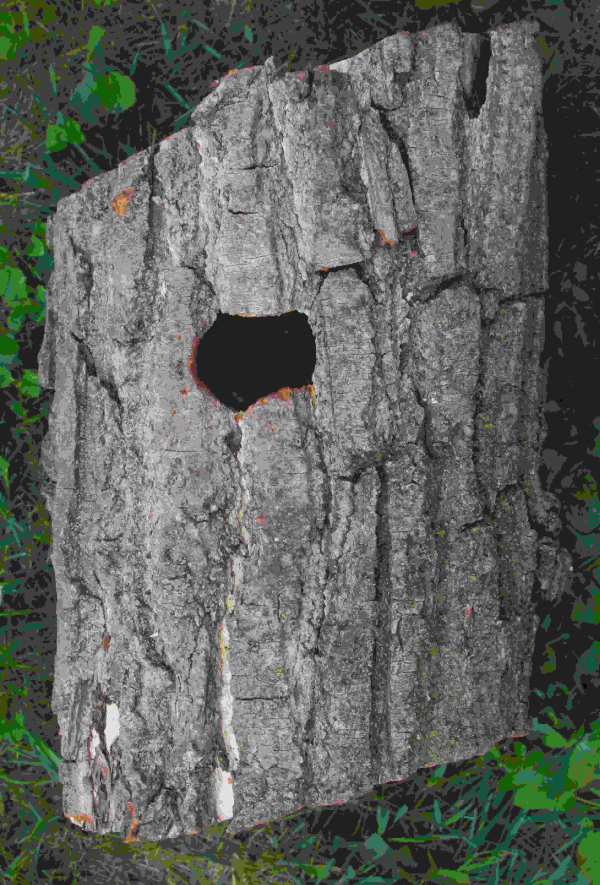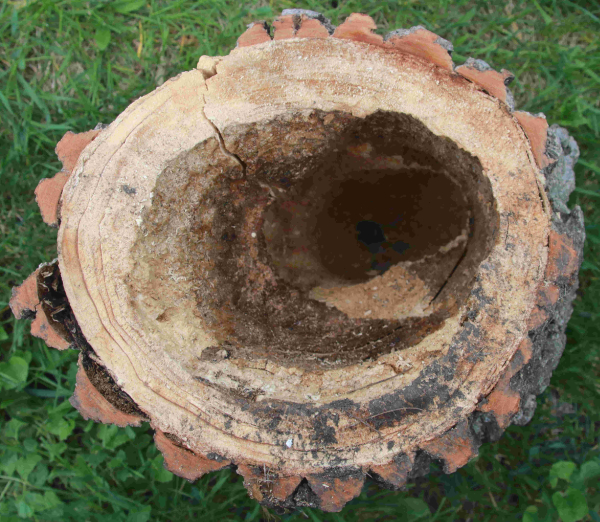
The section of a large cottonwood branch that contains a hollow that was excavated by a Northern Flicker. It’s now being recycled into a “natural” nesting cavity.

The cross-section cut of the hollow branch that shows the flicker-excavated cavity within the bottom two-thirds of the branch.
|
Last week some newly cut and stacked sections of a big tree branch caught my eye, especially one particular section that showed a hollow interior. I keep an eye out for such hollow tree sections with the idea of modifying them into a natural-looking nesting cavity for Wood Ducks, Hooded Mergansers, Eastern Screech Owls, or American Kestrels that might be attracted to them in my area. When I stopped to take a closer look at the hollow section, I was surprised to find it was actually a full-sized woodpecker cavity that was excavated by a Northern Flicker!
The big branch had been broken off during recent wind storm, and it was cut into 18-inch sections and stacked in a pile by a tree pruning company. The section I collected was cut right at the bottom of the cavity so it actually created a one-inch diameter hole on the bottom, which will work well for a drainage hole. The other end of cavity had been topped off 5 inches above the cavity entrance leaving the natural woodpecker-excavated cavity and entrance intact. The entrance measures 2¼ inch high by 3 inches wide; good for medium-sized cavity nesting birds. I have just the place for it too, so I can keep a close watch on interested occupants – on the southeast side of my rear second floor deck, which will give it about 12 feet of height above ground level.
At first I thought it might be a nesting cavity from a previous year, but then I realized if that was the case, the interior would have a fair amount of whitewash and other signs of previous use. Even a roosting cavity used during early spring or late fall would have some indications of occupancy. Therefore, it seems the cavity might have been excavated earlier this spring, although it would have been just days or a couple weeks before an intense prairie wind claimed the massive branch.
In fact, as I gave it another inspection, I could see where part of the cavity section had already become hollowed out naturally when the flicker selected it and chiseled its entrance into the natural hollow. Then the flicker worked to enlarge the hollowed area below the entrance hole, apparently chiseling the walls to its preferred dimensions. All indications suggest the cavity was ready, or nearly ready, for nesting when the big cottonwood branch came tumbling down.
Luckily, the chain saw didn’t destroy the woodpecker cavity when the branch was cut into sections. The cavity now seems to be a perfect natural nest site for mid-sized cavity nesting birds, so I am following through with minor efforts to add a top with ventilation spaces, and 4 one-inch spacers on the bottom so the cavity can drain through the1-inch hole where the chain saw nicked the bottom of the woodpecker cavity. I will also add a thin layer of wood chips to the bottom to serve the birds that use the recycled nesting cavity.
Although it’s probably too late for use this year, I expect it will be a hit with local cavity nesting birds soon – or even a roosting bird or two. Even so, I won’t permit any House Sparrows or European Starlings to hustle it from other potential native occupants.
Turning a Hollow Trunk or Branch into a Nesting Cavity
Thinking you might be interested in making a similar kind of recycled natural cavity, here is a way to turn a hollow tree trunk or branch into a mostly natural nesting cavity: Some years ago, I made a similar natural looking cavity by selecting a hollow section of a two-foot length of tree trunk section I saved from my brother’s firewood stack. In that case I was interested in attracting nesting Wood Ducks or Eastern Screech Owls, so I needed to chisel out more of the rotted wood in the interior of the trunk to make it a short wooden “tube.”
Then I cut a 4-inch diameter entrance hole near the top of it, using a large 4-inch diameter drill bit. Finally, I added a top and bottom to the hollow section of the tree trunk, leaving some air slots under the top and above the bottom for circulation and drainage – and it was ready for nesting birds. Easy enough, after you find a hollow trunk or branch.
How lucky was I to find a salvageable woodpecker cavity? I hope that luck continues with some quality birds utilizing the recycled flicker cavity over time, providing some interesting observations and photographs. I always remind people that it took 8 years of patience before Barred Owls adopted Jim Carpenter’s infamous big nest box that has been chronicled on the Wild Birds Unlimited website. But gee, I sure hope it doesn’t take that long for some appropriately sized birds to use it. How are your nest boxes fairing so far this spring?
Article and photos by Paul Konrad
Share your birding experiences and photos at editorstbw2@gmail.com